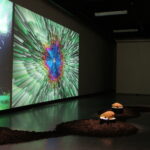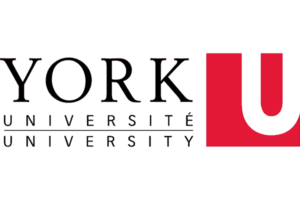(ex)tending towards
Project Description
(ex)tending towards gives form to human/forest alliances, and is driven by the following questions: What does it mean to be alive and have agency?, How can we re-train ourselves to slow down and listen to voices that have been marginalized for millennia?, and What sort of perceptual and mental shifts must occur in order to recognize and value the liveliness and precious vibrancy of individuals that do not share the same language nor temporal reality?
Foresta-Inclusive: (ex)tending towards is made up of two parts: 1) the Foresta-Inclusive sensing infrastructure installed in a forest and 2) the in-gallery connected immersive installation (ex)tending towards. The sensinginfrastructure is comprised of three sculptural sensor pods that are battery powered and send live data to an Internet of Things (IoT) prototyping platform. The sculptural sensor pods can be installed in different forests unobtrusively onto the trunk of trees and sense phenomenon such as: soil and air temperature/humidity, particulate matter (.1 μm – 10 μm), light level, wind, volatile organic compounds (VOC), C02, and rain. The in-gallery installation uses the real time data and materializes it with visual, sonic and olfactory elements. Often the work is shown during the winter, and so in this case I use a past recording from a local forest protected by the rareCharitable Reserve in Blaire, ON. CA, in lieu of live data. (ex)tending towards is comprised of two projected visualizations, sculptural elements, a four-channel sound system, and a touchless scent interface.
In response to the temporal difference between tree and human individuals, this work explores ways to slow down human engagement, and to make visible the daily experience of a tree. The aim of the work is to find ways to demonstrate the absolute liveliness of the natural world as it unfolds all around us – yet more often than not – beyond our limited sensory perception. The first visualization materializes data as a particle flow field that gently undulates and is affected in real time by changing data. Inspired by tree rings as evidence of yearly experience, the visualization is structured in the same manner and visualizes the last 24hrs of the tree’s life, where the outer ring shows contemporary values and each subsequent smaller ring the values from the previous hour. To interact with this visualization, there is a one-meter-tall cork cylinder that is also a scent sculpture, which releases the scent of geosmin (the scent of a forest after it rains) every time it rains in the forest. To interact, the participant uses a simple gestural interaction to move spatially into the visualization. The slower one moves, enables the participant to inspect each ring. The interface is embedded in soil, which also contain a set of sculptural sensor pods. Next to the visualization is a point cloud visualization of the tree at the rare Charitable Reserve. The point cloud was captured by a LIDAR scan of the forest at rare using a very large drone and rendered using Touch Designer. This point cloud is also affected in real time by live data. Like the visuals, the sonic elements materialize the forest data in a generative sound experience that balances between mimicry and poetic memory of forest experience. In its entirety this installation creates an embodied exploratory space where the deep time of a tree’s life is remembered, and the human body is slowed down in the engagement.
This work is the first in a series exploring ways of using technology as a tool to place human and non-human into a dialogical relationship, where both voices are equal despite perceived differences (temporal reality, im/mobility, non/verbal).
This work was created in collaboration with Faadhi Fauzi (three.js programming), Ilze (Kavi) Briede (point cloud wrangling and Touch Designer), and Hrysovalanti Maheras (sound design).
Video
Download the Tech Rider here
Upcoming Exhibitions
- Foresta-Inclusive: ex(tending) towards in Oscillations. Curators: Marie-Pierre Boucher and Alice Jarry. Canadian Embassy. Paris. FR. EU. 2025
Past Exhibitions:
- Foresta-Inclusive: ex(tending) towards in Oscillations. Curators: Marie-Pierre Boucher and Alice Jarry. Canadian Embassy. Paris. FR. EU. 2025
- Foresta-Inclusive: ex(tending) towards at NAISA Art Space in South River, ON. CA. 2025.
- Foresta-Inclusive: ex(tending) towards in Serendipity Arts Festival. Goa, India. 2024.
- Foresta-Inclusive: ex(tending) towards in Entangled Dimensions: Art in the Age of Neural Media. Curated by: Ryan Kelln and the City of Toronto. Toronto, On. CA. 2024.
- Foresta-Inclusive: ex(tending) towards in Tentacular Futures. Curators: Rebecca Caines and Marissa Largo. Markham, ON. CA. 2024.
- Foresta-Inclusive: (ex)tending towards. Solo-exhibition at Ottawa School of Art Gallery. Ottawa, ON. 2024
- Foresta-Inclusive: ex(tending) towards in CARBON. Science Gallery, Bengaluru India. 2023-24
- Foresta-Inclusive: ex(tending) towards in more-than-human. Curator: Jane Tingley. Onsite Gallery, Toronto, ON. CA. 2023
Acknowledgements:
Faadhi Fauzi: three.js programming for large 3D visualization.
Ilze Briede (Kavi): Touch Designer and point cloud visualization.
Hrysovalanti Maheras: Max 8 support and collaborative sound design.
Grace Grothaus: photogrammetry.
Drone and Lidar scanning: Dr Derek Robinson, Modelling and Spatial Analysis Lab, University of Waterloo, ON. CA.
Special Thanks to Kyle Duffield and Matthew Biederman for advice and pointing in the right direction.
For financial support:
Social Sciences and Humanities Research Council of Canada.
"Environments of Change" Partnership Grant from the Social Sciences and Humanities Research Council of Canada.
School of Art, Media, Performance and Design, York University, Toronto, ON. CA.
















